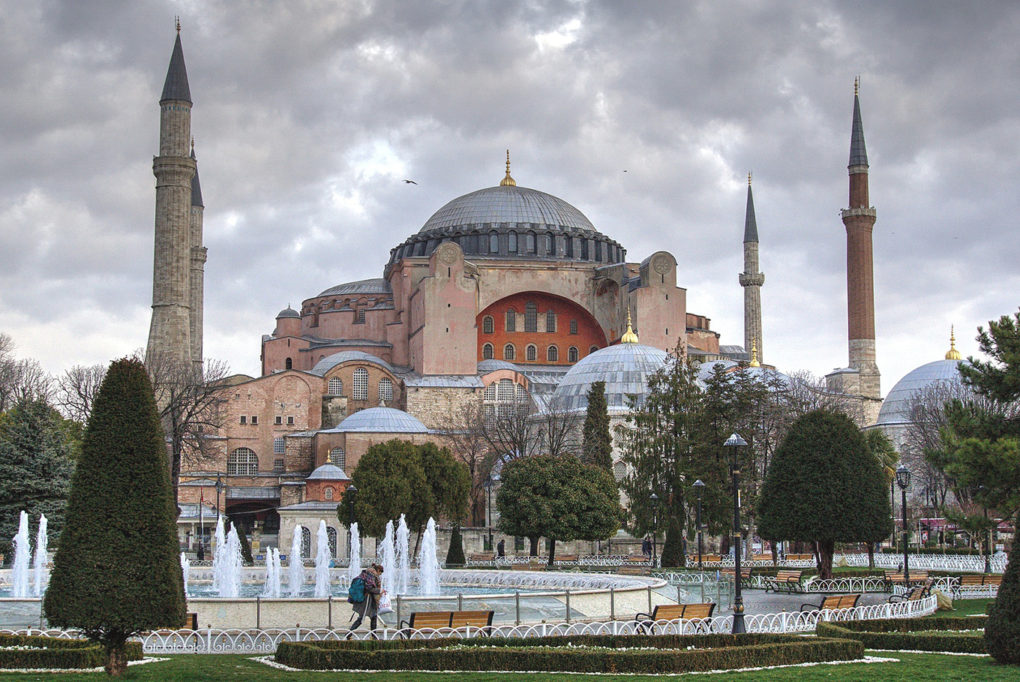
Hagia Sophia Past and Future
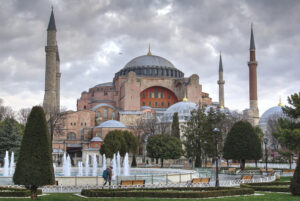
The announcement, by the Turkish president Recep Tayyip Erdogan, that Hagia Sophia was to be “reconverted” from a museum into a mosque was followed immediately by an outpouring of dismay and an upswell of enthusiasm. As it happens, this split response perfectly captures the stereotypes that now shape the prevailing understandings of the history of Islam, and the essentialization of the complex history of Islamic architecture, and, for that matter, of Eastern Christian architecture.
Clearly the decision was politically calculated, an opportunistic bid that underscores the country’s ambition to play a central geopolitical role in the Middle East. Having been denied membership in the European Union for decades, Turkey has turned instead towards the East. In this light, the reclamation of Hagia Sophia as the Great Holy Mosque of Ayasofya — after more than eight decades as a museum run by the state — can be viewed as a step towards the construction of a Turkish Islamic hegemony with increasing regional influence and also towards a new populist unity in the fragmented Islamic world.
Yet ultimately the gesture feels hollow, and worse, cynical. Indeed the reconversion can be read as a clumsy attempt to reenact the idealized glory of the defeat of the Byzantine Empire six centuries ago by the Ottomans. That victory, which was marked by the conversion of Hagia Sophia into a mosque, was followed by the territorial expansion of the Ottoman Empire across southeastern Europe, the Caucasus, the Middle East, and North Africa. The regional dominance of the empire lasted for centuries, until its defeat in World War I; and even today it provides the historical context against which this latest reconversion is perceived. Witness the positive reception by Islamist political movements and parties, such as Hamas in Palestine, the Iranian Foreign Ministry, and leaders in Pakistan, Indonesia, and Malaysia, among others. 1 For such supporters, the reconversion can be approved as part of Erdogan’s continuing campaign to reverse the secularizing reforms begun in the 1920s by Mustafa Kemal Ataturk, the founding president of the Turkish Republic. 2 A century later, the domes and minarets of Hagia Sophia will once again embody their true religio-political significance.
The negative response has been no less problematic. The criticism of Erdogan’s decision, particularly as expressed by Western institutions such as UNESCO and the European Union, has exposed the entrenched hypocrisy regarding a long and often violent history of mosque conversion. Over the centuries thousands of mosques in Spain and Greece have been converted into churches or repurposed for other uses — a history that has been largely ignored by Western authorities. Even more alarming is the lack of global attention paid to the contemporary destruction of important mosques. While the 2017 demolition of the Great Mosque of al-Nuri in Mosul, by ISIS, provoked widespread condemnation, there was scant outcry when the right-wing Hindu group Vishva Hindu Parishad razed the Babri Mosque in northern India in 1992; likewise there is little coverage of the destruction of Uighur mosques (including valued historical ones) by the Chinese Communist Party, which is happening today .
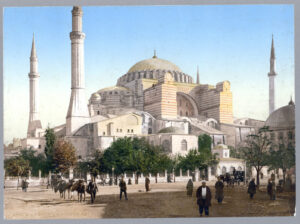
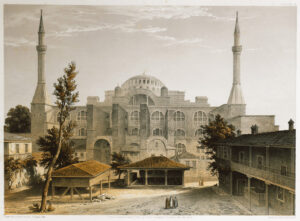
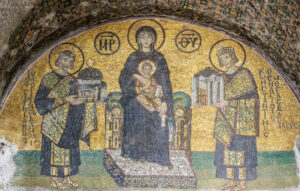
In a mirror of Erdogan’s simplistic worldview, some critics, including the Russian Orthodox Church, cling to the image of the Hagia Sophia as an eternal Christian monument. The leader of the church, Patriarch Kirill, mourned the reconversion as a “threat to all Christian civilization … to our spirituality and history.” 3 The patriarch’s concern is historically misplaced; to view Hagia Sophia as an embodiment of Christian civilization is to overlook its complicated physical and cultural evolution over many centuries. Built from 532 to 537, by the Eastern Roman emperor Justinian, Hagia Sophia was for centuries the principal cathedral of Eastern Christianity; after the Ottoman conquest, in 1453, it served as the central mosque of imperial Istanbul. It was not until the 1930s that Kemal Ataturk turned the storied structure into a museum.
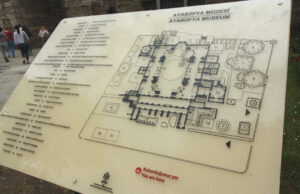

By then the building had endured numerous assaults and physical transformations. Over the centuries it suffered extensive damage from earthquakes and fires; it was sacked during the Crusades and again during the siege of Constantinople. Each time the building was repaired and restored, becoming more stylistically complex, more hybrid. In the mid 16th century, the celebrated Ottoman architect and engineer Mimar Sinan directed the construction of the massive buttresses that support the extraordinary dome to this day; also during the Ottoman period, Hagia Sophia acquired the infill of mausoleums and minarets that surround the complex. Three centuries later another renovation, by the Swiss-Italian architects Gaspare and Giuseppe Fossati, further reinforced the dome; the Fossatis also restored the Byzantine mosaics and built a madrasa on the grounds. As the art historian Gülru Necipoğlu has argued, Hagia Sophia possesses a “special propensity for adaptive reuse in different cultural and religious contexts.” She continues:
The unusual resilience of the original sixth-century structure despite numerous later additions and changes is a tribute to Justinian and his architects, whose daring experiment in dome construction remained an unsurpassed feat for many centuries. Hagia Sophia’s successive adjustment to modified circumstances and its capacity to absorb change while remaining essentially unchanged was due largely to an uninterrupted recognition of its unique formal qualities and its rich aura of symbolic associations through the centuries. 4
Other critics of the reconversion mourn the loss of Hagia Sophia as a museum, a secularized universal artifact to be experienced and valued for its wondrous architecture; a masterpiece open to all (with the payment of an entry fee). “Hagia Sophia belongs to the world,” declares an emeritus professor at King’s College London; as a museum, a “tremendous tourist attraction,” the building functions as a “global symbol of world history and multicultural representation.” 5 Colonial powers have long exploited the de-sacralization of religious architecture to justify stocking their encyclopedic museums with artifacts looted from the Islamic world a dubious practice that decontextualized the artifacts, reconceptualizing them as timeless masterpieces to be valued for their aesthetic impact.
Hagia Sophia’s transformation from mosque to museum, undertaken by the new secular Turkish nation-state, was itself a version of this process; reprogrammed as a museum, the building became a superficial signifier to be invoked by Muslim and Christian alike. A decade later, in the 1940s, the Istanbul masterplan created by the French urban planner Henri Prost whom Ataturk invited to the city as consultant resulted in the clearance of the old maidan, or Great Republic Square, located between Hagia Sophia and the Sultan Ahmet Mosque. 6 This move deactivated the urban space around the building and reinforced the reading of Hagia Sophia as a monumental to be conserved what Prost described as “universal cultural heritage belonging to humanity.” 7
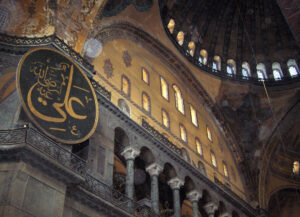
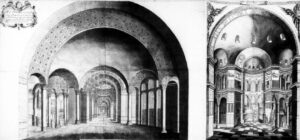
When we view the history of Islamic architecture from a longer and wider perspective, the reconversion of Hagia Sophia into a mosque ceases to seem a radical act. Indeed, the history of mosque architecture is replete with precedents that support the reversion, conversion, and alteration of historical structures into sacred spaces and vice versa; and also with structures that were, at various times, occupied by multiple religious groups, and thus shaped by legacies of religious and cultural permissiveness. Consider the Umayyad Mosque, in Damascus. Built between 709 and 715, the mosque incorporated materials from earlier religious structures that had occupied the site, including a temple to the Roman god Jupiter and a basilica dedicated to John the Baptist. 8 In its early years, the preserved temenos of the Roman temple was used by both Muslims and Christians. To this day the Umayyad Mosque houses a shrine to John the Baptist, nestled within the colonnade of the main prayer hall; and although it serves the Sunni community, the mosque houses the shrine of Husayn ibn Ali, the grandson of Muhammed, a site of pilgrimage for Shia Muslims. 9
In fact Hagia Sophia itself has the formal potential to support multiple concurrent religious practices. The building’s shifting allegiances over millennia have been assimilated into its architecture; the evocative physical traces of its lives as a church and a mosque suggest possible models for their continued co-presence. Approached thoughtfully, with keen historical insight and in close consultation with Turkish Christian groups, the space could accommodate both Muslim and Christian religious observance — and potentially other spiritual practices — and thus create a diverse and inclusive community that would become Hagia Sophia’s guardian and caretaker. In an open letter published on Medium, a group of Byzantine and Ottoman historians called for attention to be directed not towards Hagia Sophia’s function but instead towards its stewardship.
We are concerned that the ongoing dispute over function hinders the development of a management strategy commensurate to the scale of the challenges: preservation of the historical fabric and continued visibility of the works of art of all periods, Byzantine and Ottoman; responsible management of mass tourism; and protection against the threat of earthquake. … Hagia Sophia is too beautiful a monument and too precious a historical document to serve as a pawn in regional politics. Successive Byzantine, Ottoman, and Turkish governments have protected it against the ravages of time and thus maintained its significance not only for themselves, but also for those to come in the future including all of us. 10
The transformation of Hagia Sophia into a living monument a collective house of worship for the diverse communities that it has historically served is an exciting prospect. Set against the contemporary global reality of bitter culture wars, this is a future well worth pursuing.
Erdogan surely understands the controversy he is courting; he probably understands as well the complexity of the history that is at stake. Note the difference in tone and language between his English and non-English announcements. 11 The non-English version, written not in Turkish but Arabic, sounds like a victory lap. It references the historical geographic expanse of the Islamic empire “from Bukhara to Andalusia,” and describes the reconversion as retaliation for the persecution of Muslims around the world. In contrast, the English version is moderate and tempered; it deploys Western tropes to invoke the “independence” and “sovereign rights” of the nation-state as the legal grounds for the decision.
Also noteworthy is the Turkish government’s decision to maintain part of the building as a fee-free museum, open to all, and their claim that the Christian icons will be conserved. 12 This decision will maintain the public access long celebrated by proponents of the building’s recent program as a museum; Western tourists will not be frustrated in their desire to experience the splendors of Hagia Sophia. In an attempt to justify the conversion through precedent, a Turkish government spokesperson even equated the operation of Hagia Sophia as a functioning mosque and museum to that of the Notre-Dame de Paris as a functioning church and museum. Yet this comparison is unfortunate. Rather than making the case for a retrospective look at the history of the building itself, it instead unwittingly reinforces a Eurocentric legitimation for the actions of the Turkish government.
Amidst all the controversy it seems important to emphasize that Hagia Sophia has, for almost three decades, reserved a portion of the complex for use as a Muslim prayer space; since 2016 there has been a full-time Imam. For many years now the call to prayer has been sung from its pencil-shaped Ottoman minarets five times daily, to the pleasure of tourists and locals alike. Thus Hagia Sophia was already, as the authors of the open letter put it, “functioning as both a museum and a mosque.” So beyond the political symbolism of the stunt and the exposure of the expanded prayer area (moved to properly face the apse/mihrab in the main hall 13) to the view of tourists, what will change at Hagia Sophia?
For now, apparently very little.
Whatever the physical nature of the conversion, all who care about the future of Hagia Sophia as architecture and monument should call for a slow and deliberate planning process and the formation of a proper team of experts: conservationists, historians, representatives from religious groups. It is also critical that we advocate in the strongest possible terms for the preservation of the building’s Byzantine historical layers, including the famous mosaics of Christian saints that remained visible during its centuries as an Ottoman mosque. 14 But we should spare the outrage that reinforces rigid and sectarian readings, and instead inform the public debate with nuanced understandings of this complicated historical edifice. This will allow us to take full advantage of this volatile moment and dare to speculate expansively on Hagia Sophia’s potential future, given its dynamic past.
Notes
“World reacts to Turkey reconverting Hagia Sophia into a mosque,” Al Jazeera, July 11, 2020. Sinan Tavsan, “Turkish Plan to make Hagia Sophia a Mosque Splits Friends and Foes” Nikkei Asian Review, July 17, 2020. ↩
In addition to enacting a wide range of political, legal, and cultural reforms, Ataturk oversaw the conversion of thousands of mosques, including the Hagia Sophia, from spiritual to secular uses. See Hasan Kayali, “The Struggle for Independence” in The Cambridge History of Turkey, Volume 4: Turkey in The Modern World, ed. Resat Kasaba (Cambridge: Cambridge University Press, 2008), 112–146. ↩
“Russian church leader says calls to turn Hagia Sophia into mosque threaten Christianity,” Reuters, July 6, 2020. Stavros Anastasiou, “Russian Patriarch Speaks Out Against Hagia Sophia’s Conversion into Mosque,” Greek Reporter Europe, July 6, 2020. ↩
Gülru Necipoğlu, “The Life of an Imperial Monument, Hagia Sophia After Byzantium,” in Robert Mark and Ahmet S. Çakmak, eds. Hagia Sophia from the Age of Justinian to the Present (Cambridge: Cambridge University Press, 1992), 195, 207. ↩
Judith Herrin, “Converting Hagia Sophia into a mosque is an act of cultural cleansing,” Washington Post, July 15, 2020. ↩
See Cânâ Bilsel
“Remodeling the Imperial Capital in the Early Republican Era: The Representation of History in Henri Prost’s Planning of Istanbul,” in J. Osmond and A. Cimdina, editors, Power and Culture: Identity, Ideology, Representation (Pisa: Pisa University Press, 2007), 95-115. ↩
Henri Prost, quoted in Murat Gül, “Reshaping Istanbul Under Kamalist Principles 1933–1950,” in The Emergence of Modern Istanbul: Transformation and Modernization of a City (London: I.B. Tauris, 2009), 119. ↩
See Mattia Guidetti, “The Contiguity of Churches and Mosques,” in In the shadow of the church: the building of mosques in early medieval Syria (Leiden: Brill, 2017), 36–70 ↩
See Stephennie Mulder, “Four Damascene ‘Alid Shrines,” in The shrines of the ‘Alids in medieval Syria: Sunnis, Shi’is and the architecture of coexistence (Edinburgh: Edinburgh University Press, 2014), 201–220 ↩
Friends of Hagia Sophia, “An open letter about the status of Hagia Sophia,” Medium, June 30, 2020. ↩
Recep Tayyip Erdogan, President of Turkey, Twitter, July 10, 2020, 4:28 pm. ↩
Isil Sariyuce and Emma Reynolds, “Turkey’s Erdogan orders the conversion of Hagia Sophia back into a mosque,” CNN, July 10, 2020. ↩
12. The official reconversion occurred on July 24, 2020, when Friday prayers were held at Hagia Sophia. ↩
It is believed that the mosaics were in view in the mosque up to the 17th century, and then were selectively veiled or painted over. The mosaics were uncovered again in 1931. Gülru Necipoğlu, “The Life of an Imperial Monument,” 211-225. See also Caroline Goldstein, “In a Controversial Move, Turkey Will Cover Mosaics Depicting Christian Icons in the Hagia Sophia During Muslim Prayer,” Artnet, July 21, 2020. ↩


